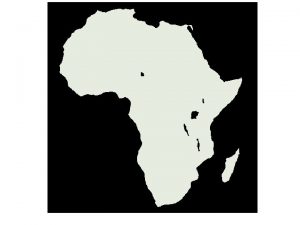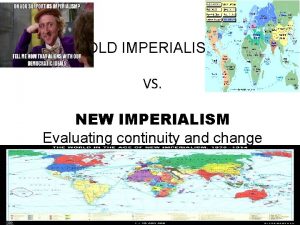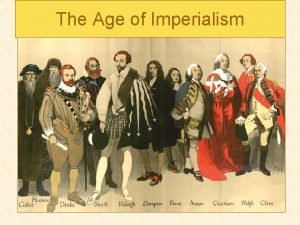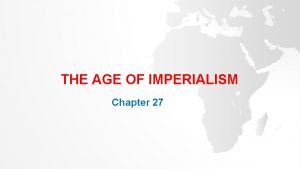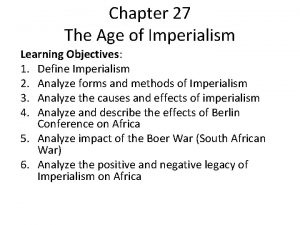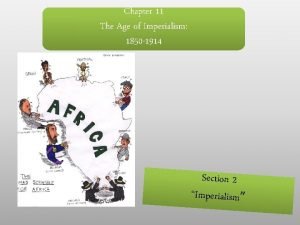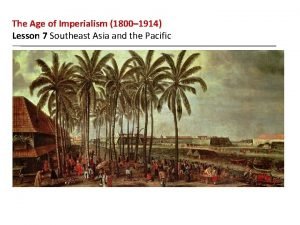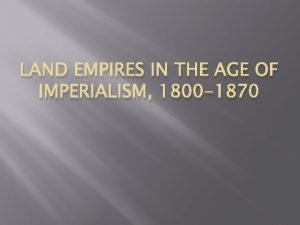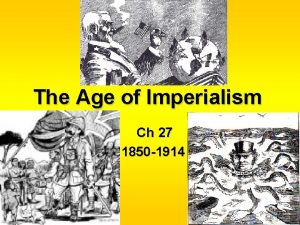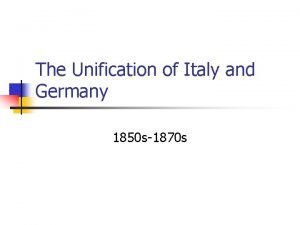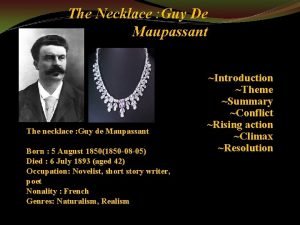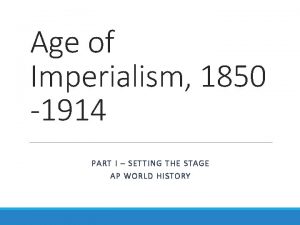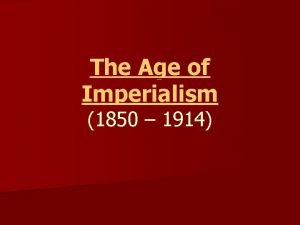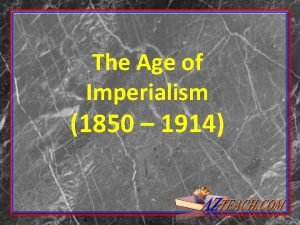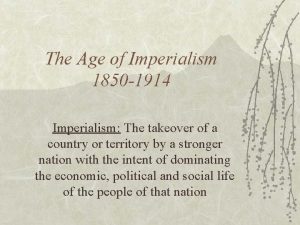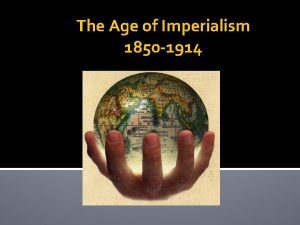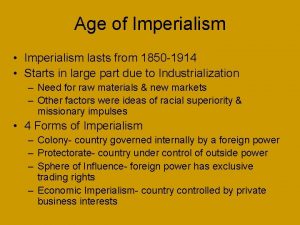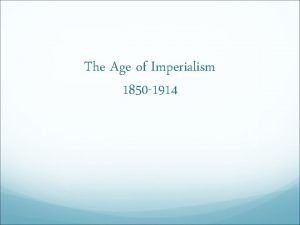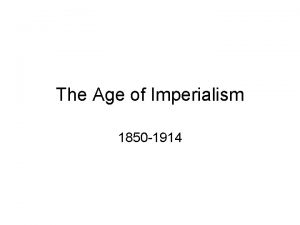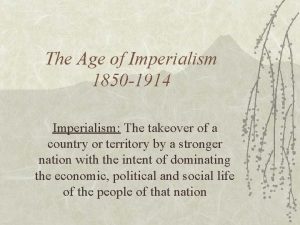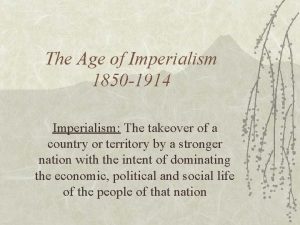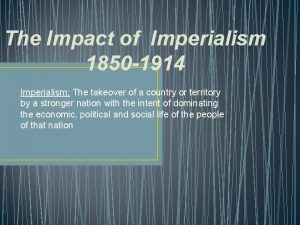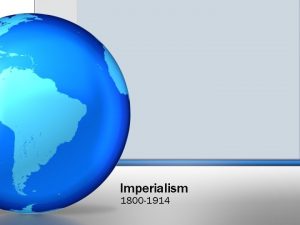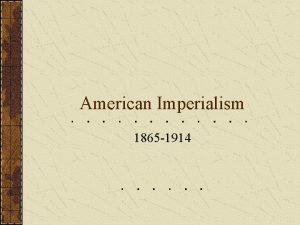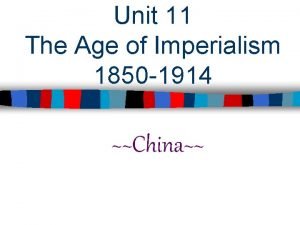Age of Imperialism 1850 1914 PART I SETTING


















- Slides: 18

Age of Imperialism, 1850 -1914 PART I – SETTING THE STAGE AP WORLD HISTORY

Imperialism The takeover of a country or territory by a stronger nation with the intent of dominating the economic, political and social life of the people of that nation

Phases of Imperialism OLD IMPERIALISM When ◦ 1450 - 1750 Countries Involved ◦ England, France, Holland, Portugal and Spain Causes ◦ Gold, God, Glory ◦ Mercantilism Consequences ◦ ◦ Columbian exchange Wars over empires Slave Trade Native populations devastated.

Interlude Late 1700 s – Late 1800 s During this period very little imperialism was going on What world events were occurring that may have hindered Imperialism ◦ American Revolution, French Revolution, Napoleonic wars, Latin American Wars for Independence, Industrial Revolution, Nationalist Revolutions.

Phases of Imperialism NEW IMPERIALISM When ◦ 1870 - 1914 Countries Involved ◦ England, France, Portugal, Spain ◦ New “Players” – Germany, Italy, Belgium, US and Japan Where? ◦ Focus on Asia and Africa Resistance ◦ Natives are not decimated by disease – Conflict between Natives and colonists increase

Motives Need for raw materials and markets due to the Industrial Revolution ◦ Especially now that it had spread all over Europe – led to competition between industrial nations ◦ Exploitation of cheap labor ◦ Opportunities for investment (mines, railways, factories, etc. ) Nationalism ◦ Desire for one’s country to get ahead in the domination of Africa and Asia and assert their political power Social Darwinism Christianize, Westernize, Civilize ◦ “White Man’s Burden” – Kipling ◦ Spread benefits of modern civilization (medicine, technology, law, sanitation, etc. )

Motives of New Imperialism The Industrial Revolution caused a need for resources to fuel industrial production in Europe and the United States Where would these resources come from? ◦ Africa ◦ Asia ◦ Latin America

Causes of New Imperialism - Economic competition between European nations; new markets to sell their goods - The need of European nations to add colonies to their empires as a measure of national greatness - Growing beliefs of racial superiority. ◦ Because they were more technologically advanced, many Europeans and Americans felt they had the right to dominate the peoples of Asia, Africa and Latin America

Causes of New Imperialism - Social Darwinism: the idea that those who were fittest for survival and success were superior to others ◦ Because of Social Darwinism, Europeans felt they had the right and duty to bring progress to other nations - Need to Christianize the people of Asia and Africa - Need to civilize and “westernize” others

What Enabled Imperialism? - Europeans’ technological superiority (including the machine gun (Maxim Gun)) - Improvements in transportation and communication to and within Asian and African colonies (Steam engines, Railroads, telegraph) - Medical advances, such as Quinine, which protected Europeans from foreign diseases (malaria) - African lack of unity ◦ African unity was difficult because of the many different languages and cultures.

How were Westerners able to colonize so many people? ◦ Not only is the technology better, but the technology can be quickly and efficiently produced in mass quantities, as the result of industrialization.

During the 19 th century, European countries (and eventually the U. S. and Japan) practiced many types of imperialism, but when they chose to set up colonies, they used two different models – compared below. Types of colonies Settlement colonies ◦ ◦ Canada Australia & New Zealand South Africa, Algeria, & Kenya Hawaii Destinations for European settlers Many European settlers; some had few natives, other had equal numbers of natives Dual goals: settlement and exploitation of natural resources Tropical Dependencies ◦ Africa ◦ Asia ◦ South Pacific Areas generally less appealing to European settlers Natives made up most of the population Main goal = exploitation of natural resources

Imperialism Timeline Look on p. 542 in World Civ. books

Imperialism in 1914

Forms of Imperialism FORMS OF IMPERIALISM CHARACTERISTICS Colony A country or region governed internally by a foreign power (India, Indonesia, Nigeria, Hawaii, etc. ) Protectorate A country with its own internal government but under the control of an outside power (Cuba) Sphere of Influence An area in which an outside power claims exclusive trading privileges (China) Economic Imperialism Independent but less developed nations controlled by private business interests rather than by other government (Iran, Argentina)

Forms of Imperialism Types of Management INDIRECT CONTROL v. Local Examples government officials were British India used British West Africa v. Limited self-rule British South Africa v. GOAL: to develop future American imperialism in the Philippines and leaders Latin America v. Government institutions are based on European styles but may have local rules

Forms of Imperialism Types of Management DIRECT CONTROL v. Foreign officials brought in to rule v. No self-rule v. GOAL: assimilation (the process in which a colonial peoples begin to adopt the culture of their rulers. ) v. Government institutions based only on European styles v. Paternalism: people governed in a fatherly way where their needs are provided for but they’re not given rights Examples v. French Algeria v. French West Africa v. French Indochina v. Belgian Congo v. German Southwest Africa

Let’s look at a few specific examples 1. European imperialism in Africa ◦ The Berlin Conference (1884 -1885) ◦ P. 551 in World Civ book 2. The Belgian Congo 3. British rule in India ◦ Battle of Plassey (1757) ◦ The Sepoy Rebellion (1857)
 Imperialism map 1914
Imperialism map 1914 Stone age chronology
Stone age chronology Iron age bronze age stone age timeline
Iron age bronze age stone age timeline New imperialism motives
New imperialism motives Old imperialism vs new imperialism
Old imperialism vs new imperialism Imperialisme
Imperialisme Chapter 27 building vocabulary the age of imperialism
Chapter 27 building vocabulary the age of imperialism Chapter 27 building vocabulary the age of imperialism
Chapter 27 building vocabulary the age of imperialism Chapter 11 the age of imperialism
Chapter 11 the age of imperialism Contrast siam's fate to that of burma and vietnam
Contrast siam's fate to that of burma and vietnam Land empires in the age of imperialism
Land empires in the age of imperialism Chapter 27 the age of imperialism
Chapter 27 the age of imperialism White man's burden apush
White man's burden apush Where was prussia in 1850
Where was prussia in 1850 Who are the characters in the story the necklace
Who are the characters in the story the necklace The necklace introduction
The necklace introduction The necklace by guy de maupassant
The necklace by guy de maupassant Sofya kovalevskaya (1850 – 1891)
Sofya kovalevskaya (1850 – 1891) N
N



